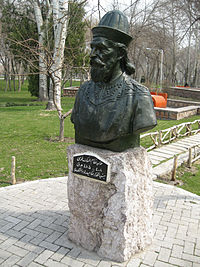- Nizam al-Mulk
-
- For info about rulers of Hyderabad state, see the page Nizam state of Hyderabad.
Abu Ali al-Hasan al-Tusi Nizam al-Mulk, better known as Khwaja Nizam al-Mulk Tusi (Persian: خواجه نظامالملک طوسی - Khwāğa Nizāmu l'Mulk al-Ṭusī, Modern Turkish: Nizamülmülk); born in 1018 – 14 October 1092) was a Persian[1][2] scholar and vizier of the Seljuq Empire. He was also for a short time the sole ruler of the Seljuq Empire.
Contents
Biography
Born in Tus in Persia (modern Iran), and initially serving the Ghaznavid sultans, Nizam al-Mulk became chief administrator of the entire Khorasan province by 1059 AD.
From 1063, he served the Seljuqs as vizier and remained in that position throughout the reigns of Alp Arslan (1063-1072) and Malik Shah I (1072-1092). He left a great impact on organization of the Seljuq governmental bodies and hence the title Nizam al-Mulk which translates as "the order of state". He was pivotal figure who bridged the political gap between both the Abbasids and the Seljuqs against their various rivals such as the Fatimids and the Buyids.
Aside from his extraordinary influence as vizier with full authority, he is also well-known for systematically founding a number of schools of higher education in several cities, the famous Nizamiyyah schools, which were named after him. In many aspects, these schools turned out to be the predecessors and models of universities that were established in Europe.
Nizam al-Mulk is also widely known for his voluminous treatise on kingship titled Siyasatnama (The Book of Government). He also wrote a book titled Dastur al-Wuzarā, written for his son Abolfath Fakhr-ol-Malek, which is not dissimilar to the famous book of Qabus nama.
Nizam al-Mulk was assassinated en route from Isfahan to Baghdad on the 10 Ramadhan of 1092 AD. The mainstream literature says he was stabbed by the dagger of a member of the Assassins (Hashshashin) sent by the notorious Hassan-i-Sabbah near Nahavand, Persia, as he was being carried on his litter. The killer approached him disguised as a dervish.[citation needed]
This account is particularly interesting in light of a possibly apocryphal story recounted by Jorge Luis Borges. In this story a pact is formed between a young Nizam al-Mulk (at that time known as Abdul Khassem) and his two friends, Omar Khayyam and Hassan-i-Sabbah. Their agreement stated that if one should rise to prominence, that they would help the other two to do likewise. Nizam al-Mulk was the first to do this when he was appointed vizier to the sultan Alp Arslan. To fulfil the pact he offered both friends positions of rank within the court. Omar refused the offer, asking instead to be given the means to continue his studies indefinitely. This Nizam did, as well as building him an observatory. Although Hassan, unlike Omar, decided to accept the appointment offered to him, he was forced to flee after plotting to dispose Nizam as vizier. Subsequently, Hassan came upon and conquered the fortress of Alamut, from where he established the Assassins.
Another report says he was killed in secret by Malik Shah I in an internal power struggle. Consequently, his murder was avenged by the vizier's loyal academics of the Nizamiyyah, by assassinating the Sultan[3] . The account is disputed and remains a controversy because of the long history of friendship between Malik Shah I and Nizam.
Another report says that he was assassinated with Malik Shah I in the same year, after a debate between Sunni and Shi'a scholars which was prepared by him by the orders of Malik Shah I and which resulted in converting him and the king to the Shi'a ideology. The story is reported by the son-in-law of Nizam al-Mulk, Muqatil bin Atiyyah who attended the debate.
See also
- List of Iranian scientists
- Persian literature
- Malik Shah I
- Alp Arslan
References
- ^ Gustave E. Von Grunebaum, Katherine Watson, Classical Islam: A History, 600 A.D. to 1258 A.D., Translated by Katherine Watson Published by Aldine Transaction, 2005. page 155
- ^ Holt, P. M.; Ann K. S. Lambton, Bernard Lewis (1977). The Cambridge History of Islam Volume 1. Cambridge University Press. p. 150.
- ^ (p. 17 of ISBN 964-303-008-3)
External links
Scholars of Khorasan Scientists: Abu Ma'shar · Abu Wafa · Abu Zayd Balkhi · Alfraganus · Ali Qushji · Avicenna · Birjandi · Biruni · Hāsib Marwazī · Ibn Hayyān · Khāzin · Khāzinī · Khujandi · Khwarizmi · Nasawi · Nasir al-Din Tusi · Omar Khayyám · Sharaf al-Din Tusi · SijziPhilosophers: Islamic Scholars: Abu Dawood · Abu Hanifa · Ahmad ibn Hanbal · Ansari · Baghavi · Bayhaqi · Bukhari · Ghazali · Hākim Nishapuri · Juwayni · Malik ibn Dinar · Maturidi · Muslim ibn al-Hajjaj · Nasa'i · Qushayri · Razi · Shaykh Tusi · Taftazani · Tirmizi · ZamakhshariPoets & Artists: Historians & Political figures: Abul-Fazl Bayhaqi · Abu Muslim Khorasani · Abu Saʿīd Gardēzī · Ali Sher Nava'i · Ata al-Mulk Juvayni · Aufi · Bal'ami · Gawhar Shad · Ibn Khordadbeh · Khalid ibn Barmak · Nizam al-Mulk · Tahir Foshanji · Yahya BarmakiCategories:- 1018 births
- 1092 deaths
- People from Tous
- Iranian scientists
- People assassinated by Hashshashin
Wikimedia Foundation. 2010.

